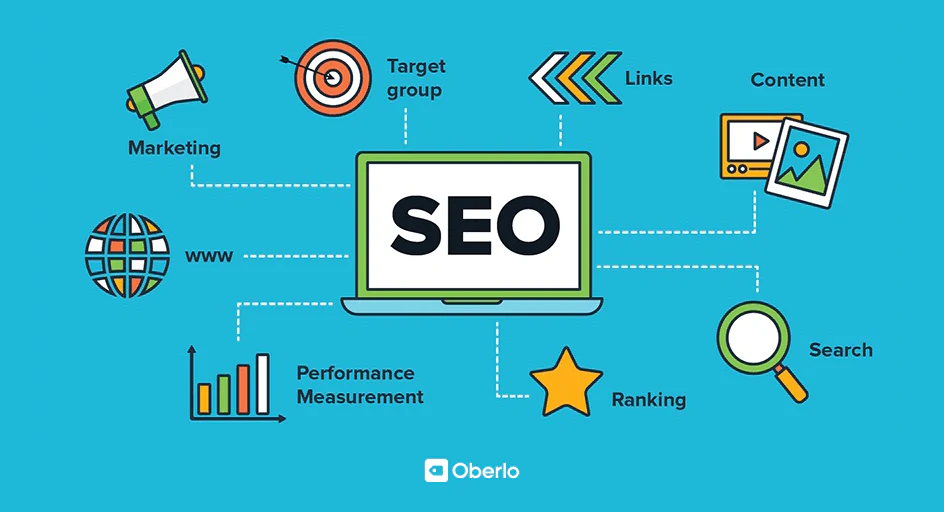Comprehending How Website Design Influences the Effectiveness of SEO Solutions
Website design plays an essential duty fit the effectiveness of search engine optimization solutions. A well-structured, mobile-responsive site can boost user experience substantially. Aspects such as website speed, clear navigating, and aesthetic charm straight affect user interaction and search positions. Nevertheless, the interaction between style elements and SEO is complicated. Understanding these nuances can reveal opportunities for improvement that many neglect. What specific layout strategies can result in better search engine optimization results?
The Relevance of Mobile Responsiveness in Search Engine Optimization
As mobile phone usage proceeds to increase, the importance of mobile responsiveness in SEO can not be overemphasized. Internet sites that adjust effortlessly to different screen dimensions have a tendency to provide better individual experiences, which is a critical variable for online search engine like Google. Mobile responsiveness improves availability, permitting customers to browse websites conveniently, regardless of their device. With a significant portion of web traffic originating from mobile tools, search engines prioritize mobile-friendly websites in their positions.
Moreover, a responsive layout can bring about reduced bounce prices, as customers are extra likely to stay on a website that operates well on their gadgets. This can result in enhanced engagement and higher conversion prices. In a period where mobile searches surpass desktop searches, disregarding mobile responsiveness can impede an internet site's presence and efficiency in reaching its target market, eventually impacting its overall search engine optimization efficiency.
How Website Speed Impacts Individual Experience and Rankings
Website speed plays a vital function in shaping customer experience and directly affects bounce rates; slower load times often bring about raised individual abandonment. Search engines prioritize faster-loading websites in their positions, making speed a significant element of efficient Search engine optimization methods. Furthermore, as mobile responsiveness comes to be increasingly crucial, optimizing site rate can enhance efficiency throughout numerous gadgets.
Impact on Bounce Rate
Internet site performance plays a crucial function in determining individual involvement and contentment. A slow-loading website can greatly enhance the bounce price, as users are most likely to desert a site that takes as well long to load. This immediate leave not only suggests a poor user experience however additionally adversely affects the site's search engine optimization rankings. Browse engines track individual actions, and a high bounce price can signal that the material is interesting or not relevant. Optimizing site rate is vital for retaining visitors and urging them to discover further. By improving load times, website owners can enhance user experience, reduce bounce rates, and produce a much more positive atmosphere for effective SEO services. Such adjustments ultimately lead to far better total efficiency and exposure online.
Internet Search Engine Prioritization
While many aspects influence online search engine rankings, site rate attracts attention as an essential component that straight affects customer experience. A faster-loading website boosts customer fulfillment, resulting in lower bounce prices and enhanced engagement. Customers are most likely to remain on a website that offers fast access to content, consequently lowering the probability of abandoning it for a rival's faster website. Internet search engine, like Google, recognize this correlation and focus on websites that supply premium rate, influencing their rankings in search results. On top of that, slow-loading sites can lead to unfavorable understandings about a brand name's integrity and reliability. Subsequently, optimizing website speed is important for businesses aiming to boost their search engine presence and overall individual experience.
Mobile Responsiveness Value
Individual experience is substantially affected by mobile responsiveness, specifically in a period where a substantial part of internet website traffic stems from mobile devices. Sites that are not maximized for mobile viewing typically bring about slower load times, which can raise and frustrate users bounce rates. Online search engine like Google prioritize mobile-friendly sites in their rankings, implying that bad mobile responsiveness can straight affect a website's exposure. A receptive layout guarantees that content is easily obtainable and aesthetically appealing, no matter device size. Consequently, this boosts individual involvement and contentment, adding to longer session periods. To sum up, mobile responsiveness is vital not just for individual experience but also for efficient search engine optimization, making it an essential factor to consider in website design techniques.
The Duty of Customer Experience (UX) in Search Engine Optimization Success

Furthermore, user-friendly UX promotes easy navigation, making it less complex for customers to find information. This convenience of accessibility can motivate repeat check outs and referrals, further intensifying a site's presence. Efficient UX design likewise encompasses quick loading times and mobile optimization, both essential aspects that affect internet search engine formulas
Navigation Framework and Its Effect On Browse Visibility
An efficient navigating structure is essential for improving search exposure, as it straight influences how both individuals and search engines connect with a web site. Clear navigation enables users to quickly find pertinent content, enhancing their experience and motivating longer website brows through. When customers browse efficiently, they are most likely to involve extra with the web content, reducing bounce prices, which favorably influences search positions.
From a search engine optimization point of view, a sensible navigation hierarchy assists internet search engine creep and index site web pages better. Well-structured Links and internal connecting facilitate the dissemination of link equity throughout the website, magnifying the visibility of important pages. In addition, a coherent navigation structure can lead to much better keyword targeting, as it permits strategic placement of keywords in menu products and subcategories. Consequently, a thoughtfully designed navigation system not only improves customer experience yet additionally plays a critical function in maximizing a web site for search engine efficiency.
Aesthetic Design Elements and Their SEO Effects

Moreover, elements like responsive layout guarantee that visuals maintain their integrity across gadgets, which is essential for SEO rankings as online search engine prioritize mobile-friendly sites. Alt message for pictures likewise plays a crucial function; it not only enhances access yet gives context to look engines, assisting in picture search optimization. Eventually, the synergy anchor between enticing visuals and technological search engine optimization practices is vital to driving natural web traffic and enhancing overall online presence.
Web Content Layout and Readability for Boosted Involvement
Efficient content format is necessary for engaging internet site site visitors and improving overall readability. A well-structured format enables users to swiftly digest and check info, enhancing the possibility that they will certainly remain on the site much longer. Using headings, subheadings, and bullet factors can separate big blocks of text, making web content a lot more visually attractive and simpler to browse.
Moreover, the critical positioning of multimedia and images aspects can match written material, providing aesthetic breaks and reinforcing crucial messages. Regular font selections and proper dimensions contribute to a sleek look, making certain that text stays legible across numerous devices.
Integrating white area right into the style not just boosts visual appeals yet likewise routes emphasis towards important elements, minimizing cognitive overload. Eventually, focusing on content design and readability fosters better individual experience, which can lead to higher interaction prices and boosted search engine rankings.
The Relevance of Clean Code and Technical SEO
Tidy code is necessary for effective web design and acts as the foundation for strong technological SEO practices. By making sure that code is effective and efficient, web sites can attain faster tons times, which improves individual experience and search engine positions. The integration of clean code and technical SEO not just enhances site efficiency however also promotes less complicated maintenance and scalability.
Relevance of Clean Code
Clarity and organization in website design are paramount, and this is where the relevance of clean code becomes apparent. Tidy code improves the site's performance and user experience, straight impacting search engine optimization performance. When a website's code is without unnecessary mess, it enables faster packing times and improved responsiveness, both of which are crucial ranking consider search engines. Additionally, well-structured code help search engine spiders in indexing material successfully, guaranteeing that crucial details is not neglected. This organization additionally helps with easier updates and upkeep, resonating with both users and programmers. Web Design and SEO Brisbane. Ultimately, tidy code serves as the structure for effective search engine optimization strategies, reinforcing the web site's overall reliability and presence in a progressively affordable digital landscape
Function of Technical Search Engine Optimization
Technical SEO plays a necessary role in enhancing a website for online search engine, linking closely with the concepts of tidy code. Clean code improves a website's framework, ensuring that search engine crawlers can browse and index web pages efficiently. visit this web-site This includes appropriate usage of HTML tags, schema markup, and XML sitemaps, which all add to far better presence in search results page. Moreover, a well-structured website with minimal errors enables enhanced customer experience, which is increasingly an element in online search engine positions. By prioritizing technical SEO, web designers can guarantee that their sites not only charm aesthetically however likewise operate effectively within search engine algorithms. Ultimately, reliable technical SEO prepares for lasting online success.
Influence on Site Speed
While numerous variables affect an internet site's efficiency, the relevance of streamlined code and robust technical search engine optimization can not be overemphasized when it comes to website speed. Clean code improves loading times by decreasing the amount of unneeded information that have to be refined, consequently giving a smoother customer experience. Technical SEO elements, such as optimized photos, appropriate caching, and decreased documents dimensions, better add to faster web page tons. Internet search engine prioritize sites that pack rapidly, as rate directly affects user retention and involvement. In an increasingly affordable electronic landscape, services should acknowledge that a well-optimized web site not only boosts speed but additionally enhances total SEO performance, bring about greater search positions and enhanced exposure.

Often Asked Concerns
Exactly How Does Internet Style Influence Click-Through Rates in Search Engine Result?
The influence of website design on click-through prices in search results is substantial. A visually enticing, straightforward design brings in customers, improving engagement and motivating clicks, inevitably enhancing an internet site's visibility and efficiency in search engine rankings.
Can Website Design Effect Bounce Fees on a Site?
Website design substantially impacts bounce rates on a site. An appealing, user-friendly design can involve site visitors much longer, while a messy or slow-loading site may bring about pop over to these guys higher bounce prices and reduced customer retention.
What Duty Does Branding Play in Search Engine Optimization Performance?
Branding markedly affects search engine optimization effectiveness by improving brand name acknowledgment and count on. A solid brand attracts more site visitors, encourages backlinks, and cultivates customer engagement, eventually boosting search positions and driving organic website traffic to the internet site in time.
How Often Should Web Style Be Upgraded for SEO Conveniences?
The regularity of website design updates for search engine optimization benefits varies; nevertheless, experts recommend taking another look at styles each to two years. Regular updates ensure perfect customer experience, boosted loading speeds, and alignment with developing SEO best practices.
Does Web Design Impact Social Media Site Sharing and Interaction?
The impact of website design on social media sharing and involvement is significant. An aesthetically enticing, user-friendly internet site motivates individuals to share material, boosting communication and visibility throughout social systems, inevitably fostering community involvement and brand name understanding.
Site rate plays an important function in forming customer experience and directly influences bounce prices; slower lots times often lead to increased customer abandonment. While numerous variables affect search engine rankings, site rate stands out as an essential part that directly influences user experience. As search engines increasingly focus on the quality of individual interaction, the role of user experience (UX) has actually ended up being critical in attaining SEO success. A well-organized navigating structure is essential for boosting search exposure, as it directly influences how both customers and search engines engage with a web site. Visual appeal plays a crucial duty in the performance of web style, greatly influencing both customer engagement and search engine optimization (SEO)